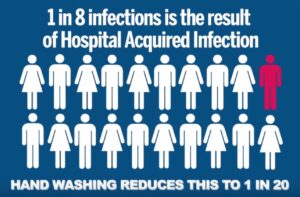Succeeding with the dirty task of hand hygiene promotion
How many psychiatrists does it take to change a light bulb? The punch line to that old joke is, of course, “One—but the light bulb has to want to change.” But just as it’s tough to get patients to modify their behaviour (quit bad habits, take up good ones, comply with their meds, etc.), it’s also difficult for ED leaders to get their staff to alter their practices for the better.
One example I find many EDs struggle with is improving hand hygiene. Despite what research has shown, some staff may believe they wash their hands plenty, thank you very much. Others may accept the evidence but struggle to remember to comply with hand hygiene guidelines, or competing priorities in a busy shift may get in the way of even the best of intentions. Access to a sink or supplies may be a problem when we provide care in hallways or waiting rooms; on the other hand, we may encounter patients stealing and drinking unsecured hand sanitizer. (Practice tip: If a patient becomes more intoxicated or less responsive after arrival in the ED, they may have consumed sanitizer.)
In this month’s guest post, Dr. Mike Wansbrough, a colleague of mine at Mount Sinai Hospital in Toronto, Ontario, talks about his journey as our department’s “hand hygiene champion” (which means I was smart enough to delegate this thankless task to someone else—thanks, Mike!). Mike is a creative guy, so when he faced frustrations in trying to change the “light bulbs” that are my medical staff, he thought an online movie in this era of YouTube sensations might help. A link to the short film is provided below; the content has been researched and vetted by infection control experts and is only four minutes long. You are welcome to use it if it helps with your own hand hygiene efforts. I plan to make it mandatory viewing for our staff.
Do you have other tips, suggestions, or resources on this issue to share? Please share them in our comments section so we can all learn from each other!
—Dr. Howard Ovens, May 2016
Written by Dr. Mike Wansbrough, edited by Carol Hilton and Anton Helman, May 2016
How to avoid getting gastro and save 8,000 patients a year in the process
Okay, I admit it: I wrote this blog to promote a four-minute movie I made recently (with lots of help) on hand hygiene. When I finally finished, I discovered my work was really just beginning; how was I to get folks to watch it?! Let’s face it; hand hygiene is not a sexy topic. It is a subject that makes people’s eyes glaze over. Promoting it is an uphill marketing slog I wouldn’t wish on Don Draper. But in the process of making the film, I was captivated.
First, let me take you back a couple of years, to the beginning of my “cleanse.” Having volunteered to be the physician “hand hygiene champion” for our emergency department (nobody else raised their hand), I was responsible for developing innovative strategies to get health-care workers (HCWs) to wash their hands. I reflected on obstacles to good hand hygiene. I researched the Internet and asked a lot of questions, and what I found was compelling.
The extent of the hand hygiene problem
I discovered that in Canada it is estimated that every year more than 200,000 patients acquire infections while in hospital, and more than 8,000 of these patients die as a result! In fact, surveys of Canadian hospital patients have shown the prevalence of health care–associated infections to be 8% among kids and 11.6% among adults. This must be a mistake, I thought, for if correct it is truly scandalous!
I scoured more sites and found a CDC report that said 1.7 million health care–associated infections occur in U.S. facilities every year, resulting in 99,000 deaths! Yet far from seeing our hands as lethal weapons requiring strict monitoring and respect, most of us see hand hygiene as an inconvenience, or as an activity to please undercover auditors (the clipboard-carrying stranger hanging around for no apparent reason) or perhaps to keep oneself from catching a patient’s nasty cold. There is a shocking lack of awareness of the death and disease we are causing.
Our hands are lethal weapons requiring strict monitoring and respect.
There is a shocking lack of awareness of the death and disease we are causing.
Why don’t we do it?
Why don’t we wash our hands? Various strategies have been tried with varying degree of success. Institutions have experimented with signs on walls, better placement of sanitizers, etc., but as any parent or spouse already knows, changing someone’s behaviour is a challenge. It cannot be dictated, mandated, or achieved through bribery; and, as any yogi will attest, true enlightenment must come from within.
Being a scientific bunch, HCWs want evidence that an intervention works before they go through the often painful implementation phase: it involves going out of their way to find hand sanitizer dispensers; squirting sticky liquid onto their hands; then awkwardly shaking hands (or not) with the patient; apologizing for wet, sticky hands if they do; then trying to write on a paper chart but not make a soggy mess of it; and remembering to do it all over again at the end of the encounter—not to mention remembering there may be two minutes of extra hand washing, depending on the circumstances. As Jerry Maguire put it, “Show me the money!”.
The challenge now is convincing health care workers that 8,000 lives
and 200,000 patients every year are worth the effort.
Stubborn doctors
In the 1840s, a Viennese physician named Ignaz Semmelweis began investigating why the rate of puerperal infections on a maternity ward run by doctors was substantially higher than on a ward run by midwives. After realizing the physicians might be transmitting diseases to their patients from corpses in the autopsy suite, Dr. Semmelweis began dipping his and others’ hands into a chlorinated lime solution and, presto, the rate of puerperal infections on his ward plummeted. Ironically, Dr. Semmelweis encountered the same challenges we face today: how to change behaviour! Doctors have always been a stubborn bunch, and after years of trying to modify his colleagues’ behaviour, Dr. Semmelweis, burned out, was committed to an asylum, where he died two weeks later at the age of 47, possibly after a severe beating by the guards. I admit that it is with considerable caution that I have taken on this project.
Louis Pasteur
But the evidence kept coming. In the 1860s, Louis Pasteur made the link between germs and disease, and Joseph Lister revolutionized operations using carbolic acid to sanitize hands, gloves, and instruments, earning himself the title of “father of modern surgery.” Many subsequent studies have shown that proper hand hygiene reduces infections. Recently, a study measuring the incidence of health care–associated infections in an ICU before and during the 2003 SARS outbreak showed a dramatic decrease in infections during the outbreak. Even increasing hand hygiene adherence by 20% can decrease the rate of health care–associated infections by as much as 40%! It is quite clear that when it is performed correctly, hand hygiene is the single most effective way to prevent the spread of infections.
Revenge of the Staph
Despite this knowledge, nasty, drug-resistant bugs such as methicillin-resistant Staphylococcus aureus (MRSA) and vancomycin-resistant enterococci (VRE) are spreading through our wards. MRSA and VRE infections are up—way up. Between 1995 and 2009, the MRSA infection rate in Canada increased by 1,000% and colonization rates rose even more.
Although rates of Clostridium difficile infection have remained steady over the past decade, this bug has gotten nastier. Only 1.5% of patients who acquired this infection died from it in 1997, whereas 5.4% of those infected died in 2010.
The Public Health Agency of Canada reports that 80% of common infections are transmitted by health-care workers, patients, and visitors.
What to do? Hand hygiene promotion
In our institution we have had varying degrees of success using different strategies, as measured by monthly auditing—yes, by that mysterious lab coat–wearing, clipboard-carrying loiterer. We have put up reminder signs. We have increased the number of hand sanitizer pumps and made them more accessible. But our greatest success has been with the nurses, by engaging them through the development of a “hand hygiene champion” position. As nurses spend time in this role, they can focus on issues of hand hygiene and monitor and provide feedback on how their colleagues perform. After some initial reservations, it became a fun, positive activity that is celebrated during the nurses’ daily team huddles.
Our greatest success has been with the nurses,
by engaging them through the development of a “hand hygiene champion” position.
Liberating Structures: Grass-roots solutions to hand hygiene promotion
Despite the success we’ve seen among our nursing colleagues, motivating the doctors and house staff continues to be a challenge. This may be due to the more independent work patterns of these groups and the resulting difficulty in creating a team environment.
There is hope! Allowing recidivists to come up with their own solutions seems to be the key. Liberating Structures is a management concept that is based on including everyone, rather than just experts, in shaping innovation. It is also an approach promoted by Dr. Michael Gardam, director of infection prevention and control at the University Health Network in Toronto. He uses these techniques to target behavioural change and has been successful in dramatically improving hand hygiene compliance by allowing for a variety of approaches, rather than forcing one “best practice” on everyone.
Liberating Structures is a management concept that is based on including everyone,
rather than just experts, in shaping innovation.
The not-so-invisible problem
Even when we think we are doing a good job with hand hygiene, we are reminded every year, usually around the winter holiday season, that we are mistaken. Consider this email from work: “Due to a gastro outbreak amongst staff, please refrain from sharing finger foods.” The proof is in the pudding!
To promote the simple but important infection-control activity, a campaign in my home province of Ontario promoted the Four Moments for Hand Hygiene:
- Before initial patient/patient environment contact
- Before an aseptic procedure (such as starting an I.V.)
- After body fluid exposure risk
- After patient/patient environment contact
We know what we need to do; the challenge now is convincing HCWs that 8,000 lives and 200,000 patients every year are worth the effort. I hope my video serves as another way to get this message across.
—Dr. Michael Wansbrough is an Assistant Professor in the Department of Family and Community Medicine at the University of Toronto, and a Staff Emergency Physician and Postgraduate Education Coordinator at the Schwartz/Reisman Emergency Centre at Mount Sinai Hospital in Toronto, Ontario.
Dr. Wansbrough, Dr. Helman and Dr. Ovens have no conflicts of interest to declare.
References
- http://www.phac-aspc.gc.ca/cphorsphc-respcacsp/2013/infections-eng.php
- Gravel D, Matlow A, Ofner-Agostini M, et al. A point prevalence survey of health care–associated infections in pediatric populations in major Canadian acute care hospitals. Am of Infect Control. 2007;35(3):157-162.
- Gravel D, Taylor G, Ofner M, et al. Point prevalence survey for healthcare-associated infections within Canadian adult acute-care hospitals. J Hosp Infect. 2007; 66(3):243-248.
-
Zoutman, D. E., Ford, B. D., Bryce, E., Gourdeau, M. et al. (2003). The state of infection surveillance and control in Canadian acute care hospitals. American Journal of Infection Control, 31(5), 266-273.
-
http://www.cdc.gov/washington/~cdcatWork/pdf/infections.pdf
- El-Masri MM and Oldfield M. Exploring the influence of enforcing infection control directives on the risk of developing healthcare associated infections in the intensive care unit: A retrospective study. Intensive Crit Care Nurs. 2012; 28(1):26-31.
- McGeer A. Hand hygiene by habit. Infection prevention: practical tips for physicians to improve hand hygiene. Ont Med Rev. 2007; 74(10):31-32.
- Public Health Agency of Canada. Results of the Surveillance of Methicillin Resistant Staphylococcus aureus, from 1995 to 2009 – A Project of the Canadian Nosocomial Infection Surveillance Program (CNISP). 2011.
Additional reading
Just Clean Your Hands (JCYH) campaign from Public Health Ontario
Thanks to Michaele Robertson, Liane Beam-Wansbrough and Howard Ovens for their advice and support in the preparation of this article.









Great video, I was excited to share this amongst my team!
Your post helps me a lot.